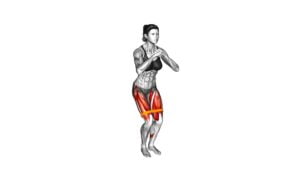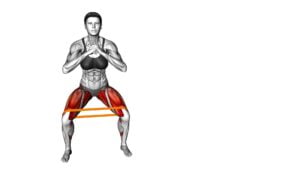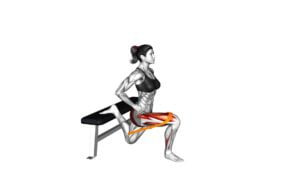Resistance Band Squat Step Out (female) – Video Exercise Guide & Tips

Are you looking for an effective lower body exercise?
Watch This Exercise Video
Try the resistance band squat step out!
In this video exercise guide, we'll show you how to perform this move with proper form and technique.
Whether you're a beginner or advanced, this exercise can be modified to suit your fitness level.
Avoid common mistakes and get tips for maximizing your workout.
Get ready to strengthen your legs and hips with this challenging yet rewarding exercise.
Let's get started!
Key Takeaways
- Resistance Band Squat Step Out engages multiple lower body muscles and improves stability and balance.
- Choosing the right resistance band is important to ensure proper form and avoid compromising your workout.
- There are variations and modifications of Resistance Band Squat Step Out that can increase the challenge and target different muscle groups.
- To maximize your workout, you can increase the intensity, add resistance bands or weight, perform exercises at a faster pace, and incorporate compound exercises for efficiency.
Benefits of Resistance Band Squat Step Out
Discover the numerous benefits you can reap from incorporating resistance band squat step outs into your fitness routine. Resistance band squat step outs are a highly effective exercise that targets multiple muscle groups, providing a wide range of benefits for your overall fitness and strength.
One of the key benefits of resistance band squat step outs is that they engage your glutes, quadriceps, hamstrings, and calves, helping to tone and strengthen these muscles. Additionally, this exercise also works your core muscles, improving stability and balance. By incorporating resistance band squat step outs into your routine, you can develop stronger legs and a firmer, more sculpted lower body.
Another advantage of resistance band squat step outs is their versatility. You can easily adjust the resistance level of the band to suit your fitness level and goals. This allows for progressive overload, which is crucial for muscle growth and strength gains. Furthermore, resistance band squat step outs can be performed anywhere, making them a convenient option for those with limited access to gym equipment.
To maximize the benefits of resistance band squat step outs, it's important to maintain proper form. Keep your knees in line with your toes, engage your core, and ensure that you're stepping out to the side with control. Start with a lighter resistance band and gradually increase the resistance as you get stronger.
Incorporating resistance band squat step outs into your fitness routine can provide numerous benefits, including stronger leg muscles, improved stability, and increased overall strength. Follow these tips and enjoy the benefits of this effective exercise.
Proper Form and Technique
How can you ensure proper form and technique while performing resistance band squat step outs?
Proper form and technique are essential for maximizing the effectiveness of your workout and reducing the risk of injury. Here are some key tips to keep in mind:
- Start with the right stance: Stand with your feet shoulder-width apart, toes pointed slightly outward. This will help stabilize your body and engage the correct muscles.
- Maintain a neutral spine: Keep your back straight and avoid rounding or arching your back. Engage your core muscles to support your spine throughout the movement.
- Control your squat: As you squat down, focus on keeping your knees in line with your toes and tracking over your ankles. Avoid letting your knees collapse inward, as this can put undue stress on your joints.
- Step out with control: As you step out to the side with one foot, maintain proper form by keeping your hips level and your knees in line with your toes. Avoid letting your knee cave in or your body lean excessively to one side.
- Avoid rushing: Take your time with each repetition, ensuring that you're performing the exercise with control and proper form. Rushing through the movement can lead to improper technique and decreased effectiveness.
Choosing the Right Resistance Band
To choose the right resistance band for your workout, consider the band strength recommendations and your body type.
Band strength recommendations vary depending on your fitness level and the intensity of your exercises. For beginners, it's best to start with a lighter resistance band and gradually increase the resistance as you get stronger.
Additionally, consider your body type and the specific areas you want to target, as different resistance bands may be more effective for certain muscle groups.
Band Strength Recommendations
When choosing the right resistance band for your workout, you can easily determine the appropriate band strength by assessing your current fitness level. Band strength recommendations are crucial to ensure optimal muscle activation during your exercises.
It's important to choose a band that provides enough resistance to challenge your muscles, but not so much that it compromises your form or causes injury. Beginners or individuals with low fitness levels should start with a lighter resistance band to allow for proper technique and muscle activation.
As you progress and become stronger, you can gradually increase the band strength to continue challenging your muscles. Remember to always listen to your body and choose a resistance band that suits your current fitness level to achieve the best results.
Considerations for Body Type
To choose the right resistance band for your body type, consider your current fitness level and the muscle activation achieved with the recommended band strength. Body type considerations play a crucial role in modifying exercises and achieving optimal results.
Here are two key points to keep in mind:
- Different body types require different resistance levels: Depending on your body type, you may need to choose a resistance band with varying levels of tension. For example, individuals with a larger frame or more muscle mass may require a stronger resistance band to effectively challenge their muscles.
- Muscle activation and targeted areas: Understanding your body type can help you identify the specific areas you want to target. Certain body types may have naturally stronger or weaker muscle groups, and choosing the right resistance band can help you focus on those areas that need more attention.
Variations and Modifications
For added challenge and variety, try incorporating different variations and modifications into your resistance band squat step out routine. By using different equipment options, you can target specific muscle groups and enhance the effectiveness of your workout.
One variation you can try is using a heavier resistance band. This will increase the resistance and make your muscles work harder. You can also try using a lighter resistance band and focus on performing the exercise with more speed and explosiveness.
Another modification is to add an overhead press to the squat step out. As you step out to the side, raise the resistance band overhead and then lower it back down as you return to the starting position. This will engage your shoulder muscles and add an upper body component to the exercise.
To target your glutes and hamstrings even more, you can perform a squat jump after stepping out to the side. Instead of returning to the starting position, explode up into a jump, and then land softly back into a squat position.
Remember to always maintain proper form and listen to your body. Incorporating variations and modifications into your resistance band squat step out routine will keep your workouts challenging and help you achieve your fitness goals.
Common Mistakes to Avoid
Avoiding common mistakes during resistance band squat step outs is essential for a successful and effective workout. To ensure you make the most out of this exercise, here are some technique tips to keep in mind:
- Maintaining proper form: One of the most common mistakes is allowing your knees to cave inwards during the squat. This can put unnecessary strain on your joints and reduce the effectiveness of the exercise. Focus on keeping your knees aligned with your toes throughout the movement.
- Not using enough resistance: Using a resistance band that's too light can limit the benefits of the exercise. Make sure to choose a band that provides enough tension to challenge your muscles. This will help you build strength and endurance more effectively.
By avoiding these common mistakes, you can maximize the benefits of resistance band squat step outs. Remember to focus on maintaining proper form and using the appropriate resistance for your fitness level.
With consistent practice and attention to detail, you'll be on your way to achieving your fitness goals in no time.
Tips for Maximizing Your Workout
To maximize your workout, incorporate these tips for maximum effectiveness.
First, focus on maximizing your results by increasing the intensity of your exercises. This can be achieved by adding resistance bands, increasing the weight, or performing exercises at a faster pace. By challenging your muscles, you'll stimulate growth and improve your overall fitness level.
Next, prioritize workout efficiency by incorporating compound exercises into your routine. Compound exercises, such as squats, lunges, and deadlifts, work multiple muscle groups at the same time, allowing you to get more done in less time. This not only saves time but also increases calorie burn and muscle activation.
In addition, make sure to properly warm up before each workout. This will increase blood flow to your muscles, improve flexibility, and reduce the risk of injury. A dynamic warm-up, including movements such as arm circles, leg swings, and high knees, will prepare your body for the upcoming workout.
To further maximize your results, consider incorporating high-intensity interval training (HIIT) into your routine. HIIT involves short bursts of intense exercise followed by periods of rest or lower-intensity exercise. This method has been shown to boost calorie burn, increase cardiovascular fitness, and improve overall workout efficiency.
Lastly, don't forget to fuel your body properly. Eating a balanced diet with adequate protein, carbohydrates, and healthy fats will provide your body with the nutrients it needs to perform at its best and maximize workout effectiveness.
Frequently Asked Questions
How Long Should I Hold the Squat Position During the Resistance Band Squat Step Out Exercise?
When performing the resistance band squat step out exercise, it's important to focus on proper form and technique. As for how long you should hold the squat position, it's recommended to hold it for a brief pause before returning to the starting position.
This helps to engage and strengthen your leg muscles effectively. Additionally, the use of resistance bands adds extra resistance and helps to improve muscle tone and strength.
Can I Perform the Resistance Band Squat Step Out Exercise if I Have Knee Pain?
To prevent injury and modify the resistance band squat step out exercise for knee pain, there are a few things you can do.
First, consult with a medical professional to ensure it's safe for you to continue exercising.
Consider using a lighter resistance band or reducing the range of motion to alleviate pressure on the knees.
Additionally, focus on engaging your glutes and core muscles to distribute the load more evenly.
Always listen to your body and stop if you experience any pain.
Is It Necessary to Warm up Before Doing the Resistance Band Squat Step Out Exercise?
Before performing the resistance band squat step out exercise, it's important for you to warm up to prevent injuries and optimize your performance. Warming up increases blood flow to your muscles, enhancing flexibility and reducing the risk of strains or sprains.
Additionally, for beginners, modifications can be made to make the exercise more manageable. These modifications include using a lighter resistance band or performing the exercise without the band until you build up strength and stability.
Can I Incorporate Other Exercises With the Resistance Band Squat Step Out to Create a Full-Body Workout?
Yes, you can definitely incorporate other exercises with the resistance band squat step out to create a full-body workout.
For upper body strength, you can try resistance band variations like bicep curls, tricep extensions, or shoulder presses.
Additionally, you can amp up the intensity by incorporating plyometric exercises like jump squats or lateral jumps with the resistance band squats.
This will help you engage multiple muscle groups and achieve a more comprehensive workout.
Are There Any Specific Breathing Techniques I Should Follow During the Resistance Band Squat Step Out Exercise?
During the resistance band squat step out exercise, it's important to follow specific breathing techniques. Proper breathing can help you maintain core stability and maximize the benefits of this exercise for your core strength.
Remember to inhale as you lower into the squat position and exhale as you push back up and step out with the resistance band. This will help you engage your core muscles and maintain control throughout the movement.
Conclusion
In conclusion, the resistance band squat step out is a highly effective exercise for targeting the lower body muscles. By using the proper form and choosing the right resistance band, you can maximize your workout and see great results.
Be sure to avoid common mistakes and try different variations to keep challenging your muscles. Incorporating this exercise into your routine will help you build strength, improve stability, and enhance overall fitness.

Author
Years ago, the spark of my life’s passion ignited in my mind the moment I stepped into the local gym for the first time. The inaugural bead of perspiration, the initial endeavor, the very first surge of endorphins, and a sense of pride that washed over me post-workout marked the beginning of my deep-seated interest in strength sports, fitness, and sports nutrition. This very curiosity blossomed rapidly into a profound fascination, propelling me to earn a Master’s degree in Physical Education from the Academy of Physical Education in Krakow, followed by a Sports Manager diploma from the Jagiellonian University. My journey of growth led me to gain more specialized qualifications, such as being a certified personal trainer with a focus on sports dietetics, a lifeguard, and an instructor for wellness and corrective gymnastics. Theoretical knowledge paired seamlessly with practical experience, reinforcing my belief that the transformation of individuals under my guidance was also a reflection of my personal growth. This belief holds true even today. Each day, I strive to push the boundaries and explore new realms. These realms gently elevate me to greater heights. The unique combination of passion for my field and the continuous quest for growth fuels my drive to break new ground.



